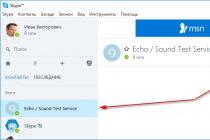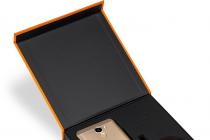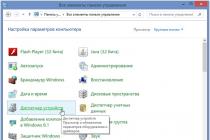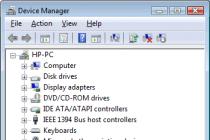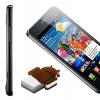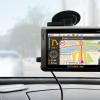Slightly grown and improved version of the "smartphone for Android applications"
Big changes swept through Microsoft's mobile division this summer. Nokia has done away with Asha's budget lineup. The software giant has ditched the ambitious McLaren project. And it was decided to transfer the Nokia X line to OS Windows Phone, ending all relations with the Android platform. But a little earlier, the manufacturer managed to present the second generation of these smartphones, which we will discuss in today's review.
Key Features Nokia X2 (RM-1013)
- Single chip system: Qualcomm Snapdragon 200 MSM8210
- Central processing unit: 2 cores Cortex-A7 (ARMv7-A) @ 1.2 GHz
- GPU: Adreno 302
- Operating system: Nokia X 2.0
- Display: IPS, 4.3 ″, 800 × 480, 217 ppi
- RAM: 1 GB
- Internal memory: 4 GB
- Support for microSD memory cards (up to 32 GB)
- Support for two SIM-cards format Micro-SIM in standby mode
- Communication GSM 850/900/1800/1900 MHz, WCDMA 900/2100 MHz
- Wi-Fi 802.11b / g / n
- Bluetooth 4.0
- GPS / A-GPS / Glonass
- Rear camera: 5 MP with autofocus and flash (720p video shooting)
- Front camera: 0.3MP
- Battery: removable, 1800 mAh
- Dimensions: 121.7 x 68.3 x 11.1mm
- Weight: 150 g
| Nokia X2 | Nokia X | Explay atom | Oppo Muse R821 | |
| Screen | 4.3 ″, IPS | 4 ″, IPS | 4 ″, TN | 4 ″, IPS |
| Permission | 800 × 480, 217 ppi | 800 × 480, 233 ppi | 800 × 480, 233 ppi | 800 × 480, 233 ppi |
| SoC | Qualcomm Snapdragon 200 MSM8210 @ 1.2 GHz (2 ARM Cortex-A7 cores) | Qualcomm Snapdragon S4 Play MSM8225 @ 1 GHz (2 ARM Cortex-A5 cores) | Mediatek MT6572 @ 1.2 GHz (2 ARM Cortex-A7 cores) | |
| GPU | Adreno 302 | Adreno 203 | Mali-400 MP | Mali-400 MP |
| RAM | 1 GB | 512 MB | 512 MB | 512 MB |
| Flash memory | 4 GB | 4 GB | 4 GB | 2.5 GB |
| Memory card support | microSD (up to 32GB) | microSD | microSD | microSD |
| SIM card support | 2 × Micro-SIM | 2 × Micro-SIM | 3 × Mini-SIM | Mini-SIM + Micro-SIM |
| Operating system* | Nokia X 2.0 | AOSP 4.1.2 with Nokia Glance Screen | Google android 4.2.2 | Google Android 4.2 |
| Battery | removable, 1800 mAh | removable, 1500 mAh | removable, 2000 mAh | removable, 1700 mAh |
| Cameras | rear (5 Mp; video - 720p), front (0.3 Mp) | rear (3 Mp) | rear (3 Mp; video - 720p), front (0.3 Mp) | |
| Size, weight | 122 x 68 x 11.1 mm, 150 g | 116 x 63 x 10.4 mm, 127 g | 126 x 64 x 13 mm, 142 g | 123 x 64 x 9.9 mm, 125 g |
| average price | T-10891269 | T-10724875 | T-10695244 | T-10515322 |
| Nokia X2 offers | ||||
* - at the time of writing the corresponding article
The second Nokia model X no longer looks "gnawed" from all sides. Volume random access memory increased to a comfortable gigabyte, a front camera and flash appeared, a more powerful SoC was installed. But at the same time, the price increased, and by a noticeable for budget segment the amount.
Equipment
The Nokia X2 comes with the same set of accessories as its predecessor. Only the headphones have been repainted in regular black. "Bright Nokia X2" did not benefit from this.

By the way, the headset does not have a call acceptance button, so you will have to take your smartphone out of your pocket when you call. The cable for connecting to the PC is still missing.
Design
Externally, Nokia X2 is not much different from its predecessor. At first glance, the only thing that catches the eye is the additional Home button under the display, which has moved the Back button to the left.

Main feature Nokia design The X2 is a two-layer casing made using the same technology as in the Nokia Asha 500/502/503. The bottom layer is made of colored polycarbonate. The upper one is made of an almost transparent polymer material, slightly tinted in the color of the lower layer.

The original Nokia X looked like a toy, largely due to its ingenious plastic casing. The second generation turned out to be much more interesting in this regard.

Phones with a two-layer case are not widespread on the market, which allows Nokia X2 to win next to discreet neighbors in the shop window due to its originality.

The rear speaker is now centered. The flash is positioned above the camera.

A closer examination of the lens and flash shows that the back cover does not fit well with the main body of the smartphone.

The mechanical buttons have hardly changed, only the volume rocker is now split by a slot.

The Micro-USB connector has been moved from the bottom to the top, towards the headphone output. The 3.5mm jack is moved down, but its hole is covered by the outer layer of the case. The rest of the smartphone has no functional elements.

To open the smartphone, you need to press on the lower corners of the case and at the same time on the rear panel, just like in Nokia X. After a few such manipulations, the colored cover starts to fit loosely and play in the lower left corner - the previous model was more reliable in this regard ...

Access to SIM1 and microSD is possible only with the battery removed. Please note that the sticker of the first model reads "Nokia", and here - "Microsoft Mobile".

The slot of the second SIM-card is located so that it can be accessible while the smartphone is in operation. The hot-swap function works perfectly here, the card is quickly detected by the phone on the go without rebooting. Another nice improvement in the series.

The build quality of the Nokia X2 is inferior to the original. It is worth removing the back cover five or six times, and it already begins to fit loosely to the body, which can sometimes be heard even by ear. In general, the second version of the smartphone became more interesting both from an aesthetic and functional point of view, but there were no fundamental changes. Perhaps we will see more daring design moves with the transition of the series to Windows.
Screen
The front surface of the screen is made in the form of a glass plate with a mirror-smooth surface, resistant to scratches. Judging by the reflection of objects anti-glare properties of the screen are not worse than those of the screen Google Nexus 7 (2013) (hereinafter simply Nexus 7). For clarity, here is a photo in which a white surface is reflected in the turned off screens of both devices (Nokia X2 is on the right, then they can be distinguished by their size):

The screen of the Nokia X2 is even slightly darker (brightness in the photos is 99 versus 101 for the Nexus 7). The tripling of reflected objects in the Nokia X2 screen is very weak, which indicates that there is no air gap between the outer glass (aka the touch sensor) and the matrix surface ( screen type OGS - One Glass Solution). Due to the smaller number of boundaries (such as glass-to-air) with very different refractive indices, such screens look better in conditions of strong external illumination, but their repair in the case of cracked outer glass is much more expensive, since the entire screen has to be changed. On the outside of the screen, there seems to be a special oleophobic (grease-repellent) coating, but its effectiveness is low therefore fingerprints appear quickly and require a relatively large amount of effort to remove.
With manual brightness control, its maximum value was about 455 cd / m², and the minimum is 9 cd / m²... The maximum brightness is high, and, given the good anti-reflective properties, at bright daylight the image on the screen should be clearly visible. In complete darkness, the brightness can be lowered to a comfortable level. There is no automatic brightness control by the light sensor. The sensor between the front speaker and the camera can be mistaken for light-sensitive, but CPU-Z indicates that it is a proximity sensor.
At any brightness level, there is modulation of the backlight with rectangular pulses with an amplitude of 100% and a frequency of 300 Hz. At high brightness, the fill factor is high, almost 100%, so there is no screen flickering; when the brightness is lowered, the fill factor decreases, and flickering can already be noticed, for example, when the eyes (or the phone relative to the eyes) move quickly. Depending on the individual, this modulation can lead to increased fatigue. Or it may not.
This screen uses matrix type IPS... The micrographs show the typical IPS subpixel structure:

For comparison, you can see the gallery of photomicrographs of screens used in mobile technology.
The screen has good viewing angles without a significant color shift even with large gaze deviations from the perpendicular to the screen and without inverting (except for the darkest shades when the gaze is deviated along one diagonal). For comparison, here is a photo in which the screens of Nexus 7 and Nokia X2 display the same images, while the brightness of the screens was initially set to about 200 cd / m2 (across the white field across the entire screen), and the color balance on the camera was forcibly switched to 6500 K. White field perpendicular to the plane of the screens:

Note the acceptable uniformity of brightness and color tone of the white field. And the test picture:

Color reproduction is good and colors are rich on both screens, but the color balance is slightly different. Now at an angle of approximately 45 ° to the plane and to the side of the screen:

It can be seen that the colors have not changed much on both screens, but in Nokia X2 the contrast has decreased to a greater extent due to a greater decrease in brightness and strong lightening of black, and there is clearly added blue. And white box:

The brightness at an angle of both screens has noticeably decreased (at least 5 times, based on the difference in exposure), but in the case of Nokia X2 the drop in brightness is much greater. At the same time, the color tone of the white field on the Nokia X2 screen has slightly changed. When deviated diagonally, the black field is lightened strongly (especially taking into account the general drop in image brightness) and acquires a violet or red-violet tint. The photos below demonstrate this (the brightness of the white areas in the direction perpendicular to the plane of the screens is the same for the screens):

And from a different angle:

With a perpendicular view, the uniformity of the black field is mediocre, since in several places along the edge the black is noticeably lightened, and the entire screen is in some spots in area:

Contrast (approximately in the center of the screen) is normal - about 700: 1. The response time for the transition black-white-black is 21 ms (10 ms on + 11 ms off). The transition between gray tones of 25% and 75% (based on the numerical value of the color) and back takes 32 ms in total. The gamma curve, plotted using 32 points with equal intervals in terms of the numerical value of the shade of gray, did not reveal a blockage either in highlights or shadows, and the exponent of the approximating power function turned out to be 2.15, which is insignificantly lower than the standard value of 2.2, while the real gamma the curve deviates little from the power-law dependence:

The color gamut differs slightly from sRGB:

The spectra show that the matrix filters mix the components together to a moderate extent:

At the same time, the coordinates of red and green colors are not very far from the corresponding vertices of sRGB, as a result, the colors of images - drawings, photographs and films - oriented to the sRGB space (and there are the overwhelming majority of them) have natural saturation and hue. The balance of shades on the gray scale is not ideal, since the color temperature is not much higher than the standard 6500 K, however, the deviation from the spectrum of a black body (ΔE) is greater than 10 (due to the excess of green), which is considered not a very good indicator even for a consumer device. However, the variation in color temperature and ΔE is small, which has a positive effect on the visual perception of color balance. Dark areas of the gray scale can be ignored, since there is no color balance of great importance, and the error in measuring color characteristics at low brightness is large.


Let's summarize. The screen has sufficiently high maximum brightness and has good anti-reflective properties, so the device can be used outdoors without any problems, even on a sunny summer day. In complete darkness, the brightness can be lowered to a comfortable level. However, the brightness will have to be adjusted manually, since there is no automatic brightness adjustment mode. The advantages of the screen include the absence of an air gap in the layers of the screen, a color gamut close to sRGB and a good - in visual assessment - color balance. The disadvantages - weak oleophobic coating, poor black stability to gaze deviation from the perpendicular to the plane of the screen, rapid drop in image brightness when viewed from an angle, not very good uniformity of the black field... We also note PWM brightness control with a frequency of 300 Hz, which can also be a disadvantage in case of individual intolerance. In general, the quality of the screen is a compromise, although not to say that it is bad.
Sound
The rear speaker in Nokia X2 seems to have been only slightly shifted, and this is where the innovations ended. The listening experience remained roughly the same as in the first model. Sound quality meets expectations from budget smartphones. No distortion appears at maximum volume.
As for the conversational dynamics, here some progress is noticeable. Nokia X2 no longer suffers from timbre distortions. But there is no need to dream about the crystal-clear communication characteristic of flagships.
You cannot record a conversation using a smartphone. There is an FM radio, which requires headphones to work.
Telephone part and communications
The Nokia X2 is equipped with two Micro-SIM slots, one of which is hot-swappable, which does not require rebooting the smartphone. Any of the cards can be assigned for data transmission, in this regard they are equivalent. Collaboration is organized in Dual Standby mode - both SIM cards are available in standby mode.
Wi-Fi 802.11 b / g / n is supported and the creation of an access point via Wi-Fi, USB and Bluetooth. Navigation in Nokia X2 works perfectly, in less than a minute it detects many satellites, not only GPS and Glonass, but also Chinese system Beidou. And immediately contacts them.

USB OTG is not supported by the smartphone, but a small amount of memory can be expanded using microSD. Out of 4 GB internal memory 2.25 GB available. Turning on the smartphone takes 50 seconds, which is much more than the average.
Camera
Nokia X2 has stepped far ahead in the possibilities of capturing photos and videos. The original model had a single camera with a resolution of only 3 megapixels. In the second version of the smartphone, it has grown to 5 megapixels and acquired a flash. In addition, a front-facing camera with a resolution of 0.3 megapixels appeared.
The main camera was commented on by Anton Soloviev:
 |
Sharpness according to plans is not bad. |
 |
Shumodav processes noise only in weak shadows. In the strong, they are noticeable, but not striking. |
 |
Despite some noise, the color of the sky is fairly even. |
 |
On the right, you can see the out-of-focus area. |
 |
The number of the nearest car is distinguishable, but more distant numbers are already impossible to make out. |
 |
Sharping on wires is practically absent. |
 |
The camera copes well with macro photography. |
 |
The camera does a good job of writing, but not all characters are clearly legible. |
For its 5 megapixel camera, the camera is not so bad, although it has a lot of problems. Shumodav tries to work as accurately as possible, and as a result produces practically no visible improvements. On the other hand, the sensor makes a rather "soft" noise, and the noise is not striking. The optics in the camera are pretty good. In some places, for some reason, there are areas of confusion, but in general, the images are quite sharp across the field and according to plans. In this case, the optics can work out more than the sensor can perceive. Nevertheless, the camera is quite good, but it does not work at all smoothly and will not cope with all the scenes. But shooting large text or general plans is within her power.
The maximum video resolution that the Nokia X2 camera is capable of is 1280 × 720.
The video is not very clear due to the low bit rate. However, if you remember that Nokia X shot a maximum of 352 × 288, progress is evident.
Software
The Nokia X2 runs on the Nokia X2 2.0 operating system (apparently based on Android 4.3). It differs from the original OS installed in Nokia X only appearance... The structure of the system has remained unchanged. The main screen contains application shortcuts in the form of tiles, just like in Windows. Swiping to the left opens the list of all applications, and swiping to the right opens the Fastlane alert feed. The operating system works, in general, is stable, but sometimes the interface lags, especially when switching between applications and when setting up the desktop
Nokia and Yandex branded stores are available to install applications. There is no Play Store. What's more, you won't even be able to add a Google account to import contacts and other information. It is not difficult to fix this.

It is easy to pre-install the driver and obtain Root rights through the utility. During installation, a request or two from the application will pop up on the phone - confirm them. Through Nokia X2 Tools you can install and Play Market... But in our case, it had a serious drawback: the program did not bind to account purchases. Therefore, we used an alternative method.
Play Market is installed in much the same way as Google services in Ramos i10 Pro. You just need to copy all three files, including Vending.apk. And take them out of it. After copying and changing permissions, restart your smartphone. Play Market is installed.
V new version Nokia X OS is even closer to the original Android. Now, by shifting from the top, you can call up two separate menus, with notifications and switches. This slightly expands the functionality, more icons are placed than before.
 |
 |
The Achilles' heel of the Nokia X was surfing the internet, which is the very slow rendering of web pages. In the second version of the smartphone, the Opera browser is installed as standard. We've browsed a lot of web pages through it and Chrome. The impressions turned out to be much more pleasant, only in rare cases the drawing lagged behind by a split second, and even then on very loaded sites.
Performance
For the second generation Nokia X, Qualcomm's SoC was also chosen. From the base series of the next generation - Qualcomm Snapdragon S200, model MSM8210.
The central processing unit consists of two Cortex-A7 cores (ARMv7-A architecture) with a frequency of 1.2 GHz. For graphics, the Adreno 302 chip is used. The configuration is quite budgetary, you shouldn't have expected more from Nokia X2. Fortunately, the manufacturer has expanded the amount of RAM to one gigabyte, which cannot but affect the performance in a favorable way.
The performance boost allows the Snapdragon 200 to easily outperform the Antutu 4 Mediatek MT6572, which is very common in budget smartphones. The previous Nokia X was not capable of this. And for Geekbench 3, there is not much difference: both SoCs have processor cores with the same characteristics. It is strange that twice the amount of RAM was not taken into account.
| Nokia X2 (Qualcomm Snapdragon 200) |
Nokia X (Qualcomm Snapdragon S4 Play) |
Explay atom (Mediatek MT6572) |
Oppo Muse R821 (Mediatek MT6572) |
|
| 3DMark Ice Storm (more is better) |
4094 | 2338 | 1882 | 1905 |
| 3DMark Ice Storm Extreme (Bigger is Better) | 2252 | 1296 | 812 | 939 |
| 3DMark Ice Storm Unlimited (more is better) | 3710 | 2245 | — | — |
| Nenamark 2 | 53.0 fps | 32.3 fps | 41.9 fps | — |
| Basemark X Middle Quality (more is better) | 3682 | — | — | — |
| Bonsai benchmark | 1634 (23.3 fps) | 823 (11.7 fps) | — | — |
| Epic Citadel High Quality | 42.9 fps | 23.4 fps | — | — |
| Epic Citadel Ultra High Quality | 32.3 fps | — | — | — |
In synthetic 3DMark, the superiority over MT6572 becomes more than twofold. Even in the most demanding Epic Citadel mode, the Snapdragon 200 SoC demonstrates a decent result
Through the efforts Google chrome the Snapdragon 200 SoC beats that of Mediatek. Based on the hardware capabilities, Nokia X2 could swing at middling games, but the very small amount of internal memory does not allow it. It is worth installing a few third party applications to fill in the gaps of the firmware, and, for example, far from the most heavyweight Asphalt 8 will complain about the lack of memory. Fans of the X series continue to get only casual entertainment.
Video playback
We did not find the MHL interface, as well as Mobility DisplayPort, in this smartphone, so we had to limit ourselves to testing the display of video files on the screen of the device itself. To do this, we used a set of test files with an arrow and a rectangle moving one division per frame (see "Testing technique for video playback and display devices. Version 1 (for mobile devices)"). Screenshots with an exposure of 1 s helped to determine the nature of the frame output of video files with different parameters: the resolution varied (1280 × 720 (720p) and 1920 × 1080 (1080p) pixels) and the frame rate (24, 25, 30, 50 and 60 frames / With). In our tests, we used a stock video player. The test results are summarized in the table:
Note: If both columns Uniformity and Skips green ratings are set, this means that, most likely, when watching movies, artifacts caused by uneven alternation and skipping of frames will either not be visible at all, or their number and visibility will not affect the viewing comfort. Red marks indicate possible problems related to the playback of the respective files.
If we restrict ourselves to the typical 24-25 fps for cinema, then according to the criterion for outputting frames, the quality of video playback on the screen of the smartphone itself is good, since frames (or groups of frames) can be displayed with a more or less uniform alternation of intervals and without frame drops. The displayed brightness range is equal to the standard range of 16-235, that is, in the shadows and highlights, all gradations of hue are displayed in the case of normal video files.
Let's try to reproduce five files of common formats.
| Format | Container, video, sound | MX Video Player | Native video player |
| DVDRip | AVI, XviD 720 × 400 2200 Kbps, MP3 + AC3 | reproduced normally | reproduced normally, no subtitles |
| Web-DL SD | AVI, XviD 720 × 400 1400 Kbps, MP3 + AC3 | reproduced normally | reproduced normally, no subtitles |
| Web-DL HD | MKV, H.264 1280 × 720 3000Kbps, AC3 | reproduced normally | played without sound |
| BDRip 720p | MKV, H.264 1280 × 720 4000 Kbps, AC3 | reproduced normally | played without sound |
| BDRip 1080p | MKV, H.264 1920 × 1080 8000Kbps, AC3 | reproduced normally | played without sound |
New budget platform Nokia X2 works well with all five common formats, whereas its predecessor could not even cope with 720p. Hardware decoding AC3 tracks are not supported.
Battery life
The Nokia X2 has a 1800 mAh battery. The developers did not reach the round value, but this is already better than the modest 1500 mAh in the first modification.

The battery consumption is not uniform throughout the entire discharge period; when calculating, it is worth adding about 6% of the time that the smartphone keeps on the last percent.
| Battery capacity | Reading mode | Video mode | 3D Game Mode | |
| Nokia X2 | 1800 mAh | 12 h 40 min | 7 h 45 min | 4 h 25 min |
| Nokia X | 1500 mAh | 14 h 15 min | 6 h. 50 min. | 3 h 50 min |
| Explay atom | 2000 mAh | 9 h 50 min | 5 h 40 min | — |
| Oppo Muse R821 | 1700 mAh | 20 h 30 min | 10 h 30 min | — |
| Oppo Mirror R819 | 2000 mAh | 10 h 20 min | 8 h 20 min | 5 h 00 mins |
| Fly Luminor IQ453 | 2000 mAh | 10 h 00 mins | 7 h 00 mins | 4 h 10 min |
| Alcatel OT Idol X | 2000 mAh | 10 h 00 mins | 6 h 40 min | 4 h 00 mins |
The autonomy of Nokia X2 has become more balanced compared to its predecessor. In reading mode, the smartphone lasts less, but it still does not yield to most competitors. But a more powerful SoC consumes more efficiently in more loaded modes, allowing you to increase the time autonomous work in games and during video playback. Charging a smartphone using the supplied adapter (5 V, 0.75 A) takes about four hours.
Conclusion
The Nokia X line continues to evolve. In the second version of the device, the functionality was expanded, the stability improved, and some annoying problems were fixed. Nokia X2 could boldly compete on all fronts with more unsightly budget smartphones, but this is difficult due to the increased price. The list of competitive advantages of the device still includes the original design, although the deterioration in the build quality spoiled the impression. Hopefully, the third version of the Nokia X will increase the flash storage to a viable 8GB, leaving Windows Mobile with something for the modest needs of the user.
ALL ORDERS WHICH ARE WAITING FOR PAYMENT WILL BE AUTOMATICALLY CANCELED WITHOUT PRIOR NOTICE AFTER DAYS.
In our online store, the price of goods indicated on the site pages is final.
The procedure for payment by electronic money, bank card, from a mobile account:
- After placing your order, your order will be placed in your Personal Area with status " Pending verification"
- Our managers will check the availability in the warehouse, and put the goods you have chosen in reserve. At the same time, the status of your order is changed to " Paid". Next to status" Paid"a link will be displayed" Pay"by clicking on which you will be taken to the page for selecting payment methods on the Robokassa website.
- After choosing a method and making payment for the order, the status will automatically change to " Paid". Further, as soon as possible, the goods will be sent to you by the delivery method selected in the process of ordering.
1. Payment in cash
It is possible to pay in cash for the purchased goods to the courier (delivering your goods), or in the store (in case of self-pickup). If you pay in cash, you will be given sales receipt, cashier's check.
ATTENTION!!! Cash on delivery DOES NOT WORK, therefore payment on delivery postal parcel impossible!
2. Payment by bank transfer
For legal entities we have provided the opportunity to pay for purchases using a cashless payment. In the process of placing an order, select the cashless payment method and enter the data for invoicing.
3. Payment through a payment terminal
ROBOKASSA - allows you to accept payments from customers usingbank cards, at any electronic currency, using servicesmobile commerce(MTS, Megafon, Beeline), payments viaInternet bankleading banks of the Russian Federation, payments through ATMs, throughinstant payment terminalsand also usingiPhone apps.
Information about the brand, model and alternative names of a specific device, if any.
Design
Information about the dimensions and weight of the device, presented in different units of measurement. Used materials, offered colors, certificates.
| Width Width information - refers to the horizontal side of the device in its standard orientation during use. | 68.3 mm (millimeters) 6.83 cm (centimeters) 0.22 ft (feet) 2.69 in (inches) |
| Height Height information - refers to the vertical side of the device in its standard orientation during use. | 121.7 mm (millimeters) 12.17 cm (centimeters) 0.4 ft (feet) 4.79 in (inches) |
| Thickness Information about the thickness of the device in different units measurements. | 11.1 mm (millimeters) 1.11 cm (centimeters) 0.04 ft (feet) 0.44 in (inches) |
| Weight Information about the weight of the device in different units of measurement. | 149 g (grams) 0.33 lbs (pounds) 5.27 oz (ounces) |
| Volume The approximate volume of the device, calculated based on the dimensions provided by the manufacturer. Refers to devices with a rectangular parallelepiped shape. | 92.26 cm³ (cubic centimeters) 5.6 in³ (cubic inches) |
| Colors Information about the colors in which this device is offered for sale. | Green Yellow Black White Grey Orange |
SIM card
A SIM card is used in mobile devices to store data that certifies the authenticity of mobile service subscribers.
Mobile networks
A mobile network is a radio system that allows multiple mobile devices to communicate with each other.
Mobile technology and data rates
Communication between devices in mobile networks is carried out using technologies that provide different data transfer rates.
Operating system
An operating system is the system software that controls and coordinates the operation of hardware components in a device.
SoC (System on Chip)
A system on a chip (SoC) integrates all the major hardware components of a mobile device into a single chip.
| SoC (System on Chip) A system on a chip (SoC) integrates various hardware components such as a processor, graphics processor, memory, peripherals, interfaces, etc., as well as the software necessary for their functioning. | Qualcomm Snapdragon 200 MSM8210 |
| Technological process Information about the technological process by which the chip is manufactured. The value in nanometers is half the distance between the elements in the processor. | 28 nm (nanometers) |
| Processor (CPU) The main function of the processor (CPU) of a mobile device is to interpret and execute instructions contained in software applications. | ARM Cortex-A7 |
| Processor size The capacity (bits) of the processor is determined by the size (in bits) of registers, address buses and buses for data. 64-bit processors offer better performance than 32-bit processors, which in turn are more efficient than 16-bit processors. | 32 bit |
| Instruction set architecture Instructions are commands with which the software sets / controls the processor. Information about the instruction set (ISA) that the processor can execute. | ARMv7 |
| L2 cache L2 (level 2) cache is slower than L1, but instead has a larger capacity to cache more data. It, like L1, is much faster than system memory (RAM). If the processor does not find the requested data in L2, it continues to look for them in L3 cache memory (if available) or in RAM memory. | 1024 KB (kilobytes) 1 MB (megabytes) |
| Number of processor cores The processor core executes program instructions... There are processors with one, two or more cores. Having more cores increases performance by allowing multiple instructions to execute in parallel. | 2 |
| CPU clock speed The clock speed of a processor describes its speed in cycles per second. It is measured in megahertz (MHz) or gigahertz (GHz). | 1200 MHz (megahertz) |
| Graphics processing unit (GPU) A graphics processing unit (GPU) handles computation for a variety of 2D / 3D graphics applications... V mobile devices ah, it is used most often by games, consumer interface, video applications, and more. | Qualcomm Adreno 302 |
| The amount of random access memory (RAM) Random access memory (RAM) used operating system and all installed applications. The data that is saved in the RAM is lost after the device is turned off or restarted. | 1 GB (gigabytes) |
| Memory type (RAM) Information about the type of random access memory (RAM) used by the device. | LPDDR2 |
Built-in memory
Each mobile device has built-in (non-removable) fixed memory.
Memory cards
Memory cards are used in mobile devices to increase the storage space for data.
Screen
The screen of a mobile device is characterized by its technology, resolution, pixel density, diagonal length, color depth, etc.
| Type / technology One of the main characteristics of the screen is the technology by which it is made and on which the image quality of information directly depends. | IPS |
| Diagonal On mobile devices, screen size is expressed in terms of the length of its diagonal, measured in inches. | 4.3 in (inches) 109.22 mm (millimeters) 10.92 cm (centimeters) |
| Width Approximate screen width | 2.21 in (inches) 56.19 mm (millimeters) 5.62 cm (centimeters) |
| Height Approximate screen height | 3.69 in (inches) 93.66 mm (millimeters) 9.37 cm (centimeters) |
| Aspect ratio The aspect ratio of the long side of the screen to its short side | 1.667:1 5:3 |
| Permission Screen resolution shows the number of pixels horizontally and vertically on the screen. More a high resolution means sharper image detail. | 480 x 800 pixels |
| Pixel density Information about the number of pixels per centimeter or inch of the screen. Higher density allows information to be shown on the screen in clearer detail. | 217 ppi (pixels per inch) 85 ppcm (pixels per centimeter) |
| Color depth Screen color depth reflects the total number of bits used for color components in one pixel. Information about the maximum number of colors that the screen can display. | 24 bit 16777216 flowers |
| Screen footprint The approximate percentage of the display area on the front of the device. | 63.52% (percent) |
| Other characteristics Information about other functions and features of the screen. | Capacitive Multitouch Scratch resistant |
| Clearblack display |
Sensors
Different sensors perform different quantitative measurements and convert physical metrics into signals that can be recognized by the mobile device.
Rear camera
The main camera of a mobile device is usually located on its rear panel and can be combined with one or more additional cameras.
| Sensor type Information about the type of camera sensor. Some of the most widely used sensor types in mobile cameras are CMOS, BSI, ISOCELL, and others. | CMOS (complementary metal-oxide semiconductor) |
| Sensor size Information about the dimensions of the photosensor used in the device. Typically, cameras with a larger sensor and lower pixel density offer more high quality images despite the lower resolution. | 3.6 x 2.7 mm (millimeters) 0.18 in (inches) |
| Pixel size Pixels are usually measured in microns. Larger pixels are capable of capturing more light and therefore provide better low-light performance and wider dynamic range than smaller pixels. On the other hand, smaller pixels allow for higher resolution while maintaining the same sensor size. | 1.406 μm (micrometers) 0.001406 mm (millimeters) |
| Crop factor The crop factor is the ratio between the size of a full-frame sensor (36 x 24 mm, equivalent to a frame of standard 35 mm film) and the size of the device's photo sensor. The number shown is the ratio of the diagonals of the full frame sensor (43.3 mm) to the photo sensor specific device. | 9.61 |
| Light-strength | f / 2.7 |
| Focal length The focal length indicates the distance in millimeters from the sensor to the optical center of the lens. Equivalent focal length (35mm) is the focal length of a mobile device camera, equated to the focal length of a 35mm full-frame sensor, at which the same angle of view will be achieved. It is calculated by multiplying the real focal length of the mobile device camera by the crop factor of its sensor. The crop factor can be defined as the ratio between the diagonals of a 35mm full-size sensor and a mobile device sensor. | 3.13 mm (millimeters) 30.11 mm (millimeters) * (35 mm / full frame) |
| Flash type The rear (rear) cameras of mobile devices mainly use LED flashes. They can be configured with one, two or more light sources and vary in shape. | LED |
| Image Resolution | 2560 x 1920 pixels 4.92 MP (megapixels) |
| Video resolution | 1280 x 720 pixels 0.92 MP (megapixels) |
| Video recording rate (frame rate) Information about the maximum recording rate (frames per second, fps) supported by the camera at maximum resolution. Some of the most basic video recording speeds are 24 fps, 25 fps, 30 fps, 60 fps. | 30 frames / sec (frames per second) |
| Specifications Information about additional software and hardware features of the rear (rear) camera. | Autofocus Digital zoom Geographic tags Touch focus Exposure compensation |
Front-camera
Smartphones have one or more front cameras of different designs - pop-up camera, PTZ camera, notch or hole in the display, camera under the display.
| Light-strength Aperture (also known as aperture, aperture, or f-number) is a measure of the size of the lens aperture, which determines the amount of light entering the sensor. The lower the f-number, the larger the aperture and the more light reaches the sensor. Usually, the f-number is indicated, which corresponds to the largest possible aperture of the aperture. | f / 2.8 |
| Image Resolution Resolution is one of the main characteristics of cameras. It represents the number of horizontal and vertical pixels in the image. For convenience, smartphone manufacturers often quote resolutions in megapixels, indicating the approximate number of pixels in millions. | 640 x 480 pixels 0.31 MP (megapixels) |
| Video resolution Information about the maximum video resolution that the camera can record. | 640 x 480 pixels 0.31 MP (megapixels) |
Audio
Information about the type of speakers and audio technology supported by the device.
Radio
The radio of the mobile device is a built-in FM receiver.
Locating
Information about the navigation and positioning technologies supported by the device.
Wi-Fi
Wi-Fi is a technology that enables wireless communication for transferring data over short distances between various devices.
Bluetooth
Bluetooth is a standard for secure wireless transfer of data between different types of devices over short distances.
| Version There are several Bluetooth versions, while each subsequent one improves the speed of communication, coverage, contributes to easier detection and connection of devices. Information about the Bluetooth version of the device. | 4.0 |
| Specifications Bluetooth uses different profiles and protocols to provide more fast exchange data saving, energy saving, better device discovery, etc. Some of these profiles and protocols that the device supports are shown here. | A2DP (Advanced Audio Distribution Profile) AVRCP (Audio / Visual Remote control Profile) FTP (File Transfer Profile) GAVDP (Generic Audio / Video Distribution Profile) HFP (Hands-Free Profile) HID (Human Interface Profile) HSP (Headset Profile) OPP (Object Push Profile) PAN (Personal Area Networking Profile) PBAP / PAB (Phone Book Access Profile) Hs |
USB
USB (Universal Serial Bus) is an industry standard that allows different electronic devices to exchange data.
Headphone jack
This is an audio connector, which is also called an audio connector. The most widely used standard in mobile devices is the 3.5mm headphone jack.
Connecting devices
Information about other important connection technologies supported by the device.
Browser
A web browser is a software application for accessing and viewing information on the Internet.
| Browser Information about some of the main features and standards supported by the device browser. | Html HTML5 CSS 3 |
Audio file formats / codecs
Mobile devices support different audio file formats and codecs, which respectively store and encode / decode digital audio data.
Video file formats / codecs
Mobile devices support different video file formats and codecs, which respectively store and encode / decode digital video data.
Battery
Mobile device batteries differ in their capacity and technology. They provide the electrical charge required for their function.
| Capacity Battery capacity indicates the maximum charge it can store, measured in milliampere-hours. | 1800 mAh (milliampere-hours) |
| A type The type of battery is determined by its structure and, more precisely, by the chemicals used. Exists different types lithium-ion and lithium-ion-polymer batteries are most commonly used in mobile devices. | Li-Ion (Lithium-ion) |
| Talk time 2G Talk time in 2G is the period of time during which the battery charge is completely discharged during continuous talk on a 2G network. | 10 h (hours) 600 min (minutes) 0.4 days |
| Standby time 2G Standby time in 2G is the period of time during which the battery charge is completely discharged when the device is in stand-by mode and connected to a 2G network. | 552 h (hours) 33120 mins (minutes) 23 days |
| Talk time 3G Talk time in 3G is the period of time during which the battery charge is completely discharged during a continuous conversation on a 3G network. | 13 h (hours) 780 minutes (minutes) 0.5 days |
| 3G standby time Standby time in 3G is the period of time during which the battery charge is completely discharged when the device is in stand-by mode and connected to a 3G network. | 552 h (hours) 33120 mins (minutes) 23 days |
| Specifications Information about some additional characteristics of the device's battery. | Removable |
| Battery model: BV-5S |
Specific Absorption Rate (SAR)
SAR levels refer to the amount of electromagnetic radiation absorbed by the human body when using a mobile device.
| SAR level for head (EU) The SAR level indicates maximum amount electromagnetic radiation to which the human body is exposed if you hold a mobile device close to your ear in a talking position. In Europe, the maximum SAR value for mobile devices is limited to 2 W / kg per 10 grams of human tissue. This standard was established by the CENELEC committee in accordance with the IEC standards, following the ICNIRP guidelines of 1998. | 0.81 W / kg (Watts per kilogram) |
| Body SAR (EU) The SAR level indicates the maximum amount of electromagnetic radiation that a person's body is exposed to when holding a mobile device at hip level. The highest SAR value for mobile devices in Europe is 2 W / kg per 10 grams of human tissue. This standard was established by the CENELEC committee in accordance with ICNIRP guidelines from 1998 and IEC standards. | 0.78 W / kg (Watts per kilogram) |
| Head SAR (US) The SAR level indicates the maximum amount of electromagnetic radiation that a person's body is exposed to if a mobile device is held close to the ear. The maximum value used in the United States is 1.6 W / kg per gram of human tissue. US mobile devices are controlled by CTIA and the FCC conducts tests and sets their SAR values. | 0.99 W / kg (Watts per kilogram) |
| Body SAR (US) The SAR level indicates the maximum amount of electromagnetic radiation that a person's body is exposed to when holding a mobile device at hip level. The highest SAR value in the United States is 1.6 W / kg per gram of human tissue. This value is set by the FCC and CTIA monitors mobile devices for compliance with this standard. | 0.53 W / kg (Watts per kilogram) |


